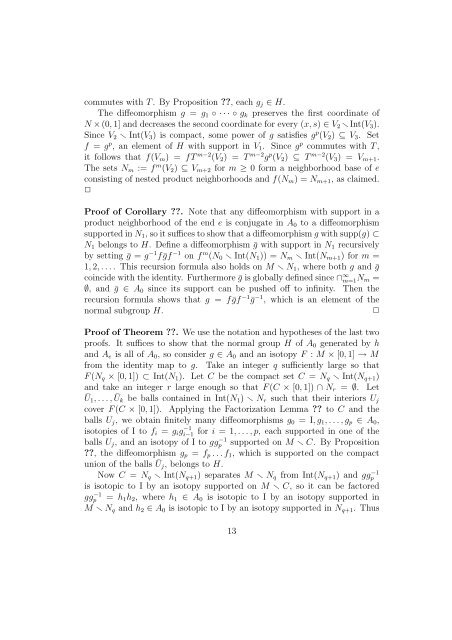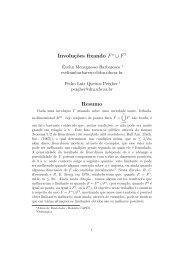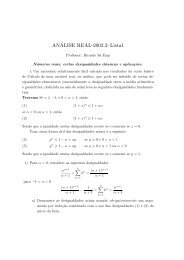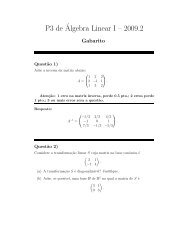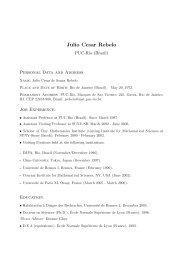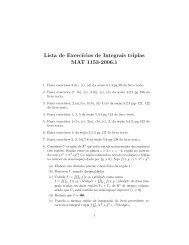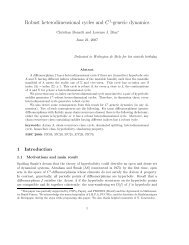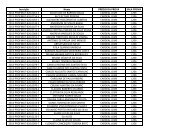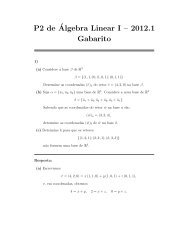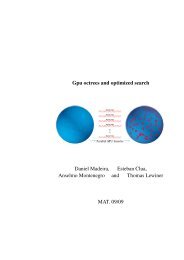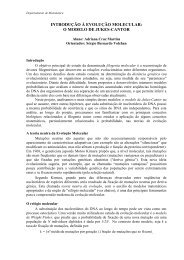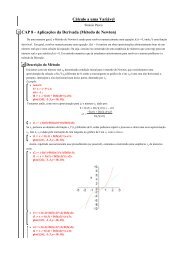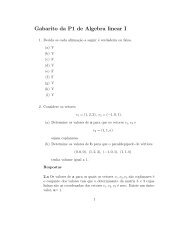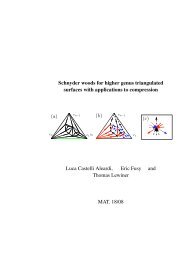NORMAL SUBGROUPS OF DIFFEOMORPHISM AND ...
NORMAL SUBGROUPS OF DIFFEOMORPHISM AND ...
NORMAL SUBGROUPS OF DIFFEOMORPHISM AND ...
Create successful ePaper yourself
Turn your PDF publications into a flip-book with our unique Google optimized e-Paper software.
commutes with T . By Proposition ??, each g j ∈ H.<br />
The diffeomorphism g = g 1 ◦ · · · ◦ g k preserves the first coordinate of<br />
N ×(0, 1] and decreases the second coordinate for every (x, s) ∈ V 2 Int(V 3 ).<br />
Since V 2 Int(V 3 ) is compact, some power of g satisfies g p (V 2 ) ⊆ V 3 . Set<br />
f = g p , an element of H with support in V 1 . Since g p commutes with T ,<br />
it follows that f(V m ) = fT m−2 (V 2 ) = T m−2 g p (V 2 ) ⊆ T m−2 (V 3 ) = V m+1 .<br />
The sets N m := f m (V 2 ) ⊆ V m+2 for m ≥ 0 form a neighborhood base of e<br />
consisting of nested product neighborhoods and f(N m ) = N m+1 , as claimed.<br />
✷<br />
Proof of Corollary ??. Note that any diffeomorphism with support in a<br />
product neighborhood of the end e is conjugate in A 0 to a diffeomorphism<br />
supported in N 1 , so it suffices to show that a diffeomorphism g with supp(g) ⊂<br />
N 1 belongs to H. Define a diffeomorphism ḡ with support in N 1 recursively<br />
by setting ḡ = g −1 fḡf −1 on f m (N 0 Int(N 1 )) = N m Int(N m+1 ) for m =<br />
1, 2, . . . . This recursion formula also holds on M N 1 , where both g and ḡ<br />
coincide with the identity. Furthermore ḡ is globally defined since ∩ ∞ m=1N m =<br />
∅, and ḡ ∈ A 0 since its support can be pushed off to infinity. Then the<br />
recursion formula shows that g = fḡf −1 ḡ −1 , which is an element of the<br />
normal subgroup H.<br />
✷<br />
Proof of Theorem ??. We use the notation and hypotheses of the last two<br />
proofs. It suffices to show that the normal group H of A 0 generated by h<br />
and A e is all of A 0 , so consider g ∈ A 0 and an isotopy F : M × [0, 1] → M<br />
from the identity map to g. Take an integer q sufficiently large so that<br />
F (N q × [0, 1]) ⊂ Int(N 1 ). Let C be the compact set C = N q Int(N q+1 )<br />
and take an integer r large enough so that F (C × [0, 1]) ∩ N r = ∅. Let<br />
Ū 1 , . . . , Ūk be balls contained in Int(N 1 ) N r such that their interiors U j<br />
cover F (C × [0, 1]). Applying the Factorization Lemma ?? to C and the<br />
balls U j , we obtain finitely many diffeomorphisms g 0 = I, g 1 , . . . , g p ∈ A 0 ,<br />
isotopies of I to f i = g i g −1<br />
i−1 for i = 1, . . . , p, each supported in one of the<br />
balls U j , and an isotopy of I to ggp<br />
−1 supported on M C. By Proposition<br />
??, the diffeomorphism g p = f p . . . f 1 , which is supported on the compact<br />
union of the balls Ūj, belongs to H.<br />
Now C = N q Int(N q+1 ) separates M N q from Int(N q+1 ) and ggp<br />
−1<br />
is isotopic to I by an isotopy supported on M C, so it can be factored<br />
ggp −1 = h 1 h 2 , where h 1 ∈ A 0 is isotopic to I by an isotopy supported in<br />
M N q and h 2 ∈ A 0 is isotopic to I by an isotopy supported in N q+1 . Thus<br />
13


